#Women's history
Text
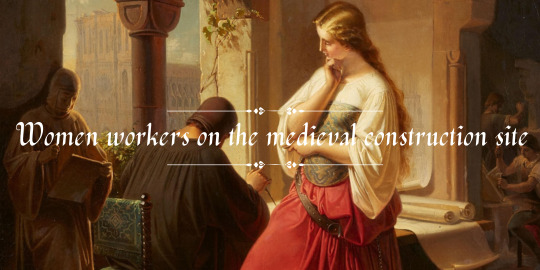
"Women could be found working on construction sites, if only occasionally, including in specialized roles such as carpenters and masons. The research is found in the article, “Appropriate to Her Sex?” Women’s Participation on the Construction Site in Medieval and Early Modern Europe,” by Shelley E. Roff.
She surveyed a wide variety of records from throughout Western Europe, including tax records, inventories of wages paid on construction sites, and municipal accounts, and discovered numerous instances of women working alongside men on construction sites as far back at the 13th century. Most of these women were employed as day laborers, carrying out tasks such as moving water and building supplies around the sites, digging ditches and serving as assistants to bricklayers and stonemasons. For example, in the Spanish city of Seville during the 14th century, women were hired to dig trenches for the foundation of a new city wall, while at the nearby city of Toledo, one or two women were hired each day for the construction of the city’s cathedral, where they gathered lime and worked on the roof. Meanwhile in the French city of Toulouse, almost half the laborers working on the Perigord college site were women. Ross also finds several examples from England and Germany.
Roff notes that previous historians have seen many examples of women working on construction sites in their research, but they had believed that these were just abnormal exceptions caused by economic crises, or because the male population had been killed off through war or disease. But her new study suggests that women construction workers were more than just odd occurences. She explains that “the expansion of urban centers starting in the thirteenth century set off a trend of increasing female employment for day laborers and in the crafts, which only began to contract on occasion for women working in the crafts in the sixteenth century with ensuing economic crises.”
She also notes that in almost all accounts surveyed, the women were paid at a lower rate than the men, which would make the “a cost-effective solution” for site supervisors looking for ways to reduce expenses. The women who took these jobs would have come from society’s poor – those women who could not maintain their households and families just from their husbands’ (if they had one) income.
Roff also finds records showing women taking part in specialized building trades. In London in 1383, Katherine Lightfoot is recorded as the supplier of 2,000 painted tiles for bath in the King’s palace. Meanwhile, tax records from Paris during the years 1296 and 1313 reveal the existence of two female masons, a tiler and a plasterer. These women were not poorer individuals, rather they were the wives of male craftsman, and in some cases their widows. The 15th-century French writer Christine de Pizan noted in her book The Treasury of the City of Ladies that craftswomen, “should learn all the shop details so that she can properly supervise the workers when her husband is away or not paying attention.”
Women workers could be found on the medieval construction site, Medievalists.net
#history#women in history#women's history#working women#historyedit#middle ages#medieval women#medieval history#european history#french history#spanish history#historical#historyblr
117 notes
·
View notes
Text
Which Underrated Woman from History are You?
Finally got around to making a uquiz featuring six of my favourite women from history! You can either get someone from the French Revolution, Roman Republic (I know, how unexpected!) or from 1700s/early 1800s.
Featuring scientists, writers, politically active icons and a few poets whose lives were intertwined with theirs, as a treat!
Enjoy and thanks everyone for sharing! ✨
#frev#french revolution#ancient rome#roman republic#history#tagamemnon#uquiz#tumblr quiz#which are you?#age of enlightenment#1700s#1800s#romantic era#18th century#19th century#émilie du châtelet#fulvia#clodia#mary shelley#ada lovelace#lord byron#literature#women's history#uquiz link#personality quiz#quiz tag#percy bysshe shelley#lucile desmoulins#camille desmoulins#catullus
38 notes
·
View notes
Text
Women's Not So Distant History
This #WomensHistoryMonth, let's not forget how many of our rights were only won in recent decades, and weren’t acquired by asking nicely and waiting. We need to fight for our rights. Here's are a few examples:

📍 Before 1974's Fair Credit Opportunity Act made it illegal for financial institutions to discriminate against applicants' gender, banks could refuse women a credit card. Women won the right to open a bank account in the 1960s, but many banks still refused without a husband’s signature. This allowed men to continue to have control over women’s bank accounts. Unmarried women were often refused service by financial institutions entirely.
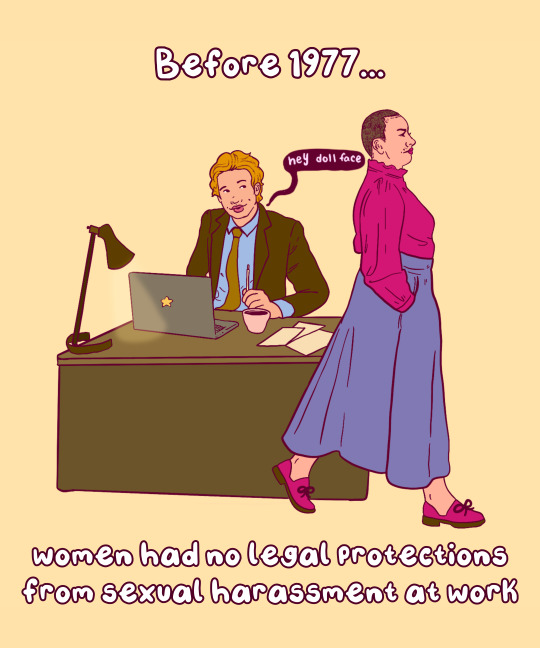
📍 Before 1977, sexual harassment was not considered a legal offense. That changed when a woman brought her boss to court after she refused his sexual advances and was fired. The court stated that her termination violated the 1974 Civil Rights Act, which made employment discrimination illegal.⚖️
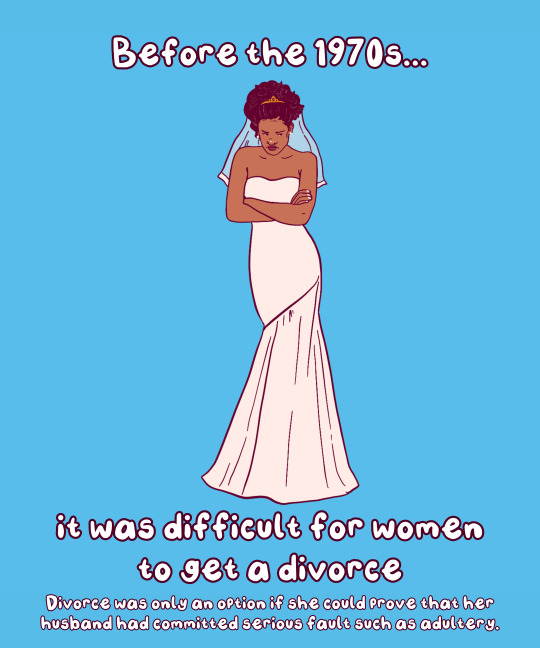
📍 In 1969, California became the first state to pass legislation to allow no-fault divorce. Before then, divorce could only be obtained if a woman could prove that her husband had committed serious faults such as adultery. 💍By 1977, nine states had adopted no-fault divorce laws, and by late 1983, every state had but two. The last, New York, adopted a law in 2010.
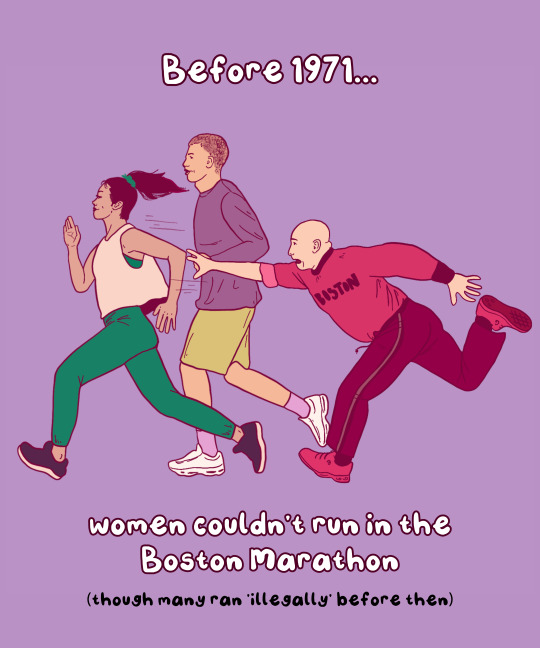
📍In 1967, Kathrine Switzer, entered the Boston Marathon under the name "K.V. Switzer." At the time, the Amateur Athletics Union didn't allow women. Once discovered, staff tried to remove Switzer from the race, but she finished. AAU did not formally accept women until fall 1971.

📍 In 1972, Lillian Garland, a receptionist at a California bank, went on unpaid leave to have a baby and when she returned, her position was filled. Her lawsuit led to 1978's Pregnancy Discrimination Act, which found that discriminating against pregnant people is unlawful
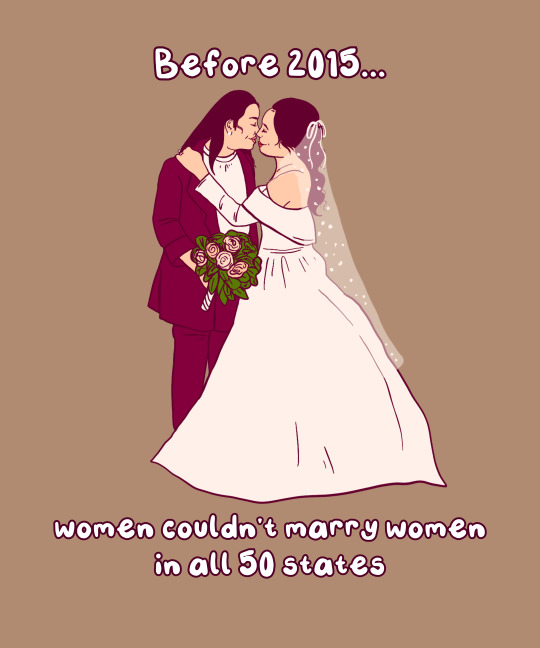
📍 It wasn’t until 2016 that gay marriage was legal in all 50 states. Previously, laws varied by state, and while many states allowed for civil unions for same-sex couples, it created a separate but equal standard. In 2008, California was the first state to achieve marriage equality, only to reverse that right following a ballot initiative later that year.

📍In 2018, Utah and Idaho were the last two states that lacked clear legislation protecting chest or breast feeding parents from obscenity laws. At the time, an Idaho congressman complained women would, "whip it out and do it anywhere,"
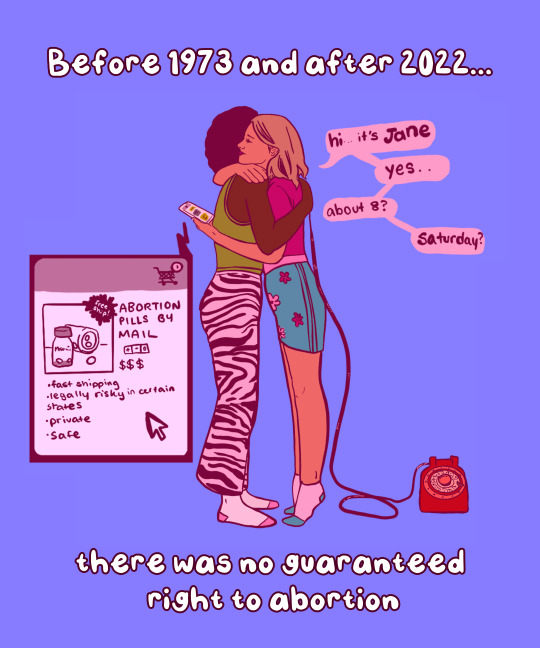
📍 In 1973, the Supreme Court affirmed the right to safe legal abortion in Roe v. Wade. At the time of the decision, nearly all states outlawed abortion with few exceptions. In 1965, illegal abortions made up one-sixth of all pregnancy- and childbirth-related deaths. Unfortunately after years of abortion restrictions and bans, the Supreme Court overturned Roe in 2022. Since then, 14 states have fully banned care, and another 7 severely restrict it – leaving most of the south and midwest without access.
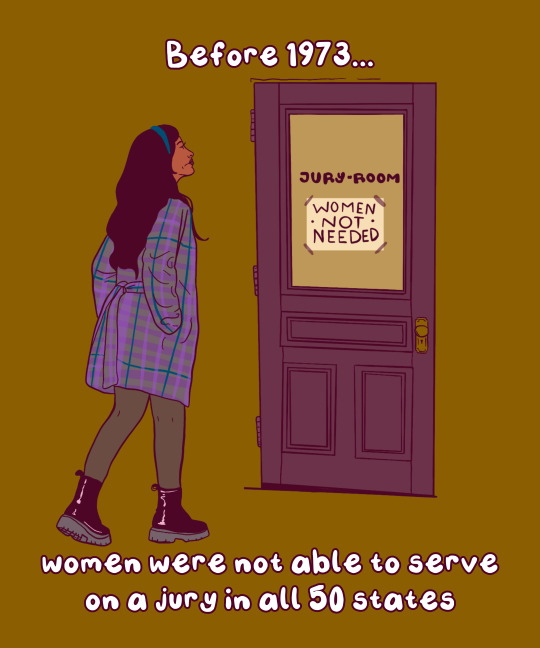
📍 Before 1973, women were not able to serve on a jury in all 50 states. However, this varied by state: Utah was the first state to allow women to serve jury duty in 1898. Though, by 1927, only 19 states allowed women to serve jury duty. The Civil Rights Act of 1957 gave women the right to serve on federal juries, though it wasn't until 1973 that all 50 states passed similar legislation

📍 Before 1988, women were unable to get a business loan on their own. The Women's Business Ownership Act of 1988 allowed women to get loans without a male co-signer and removed other barriers to women in business. The number of women-owned businesses increased by 31 times in the last four decades.
Free download

📍 Before 1965, married women had no right to birth control. In Griswold v. Connecticut (1965), the Supreme Court ruled that banning the use of contraceptives violated the right to marital privacy.
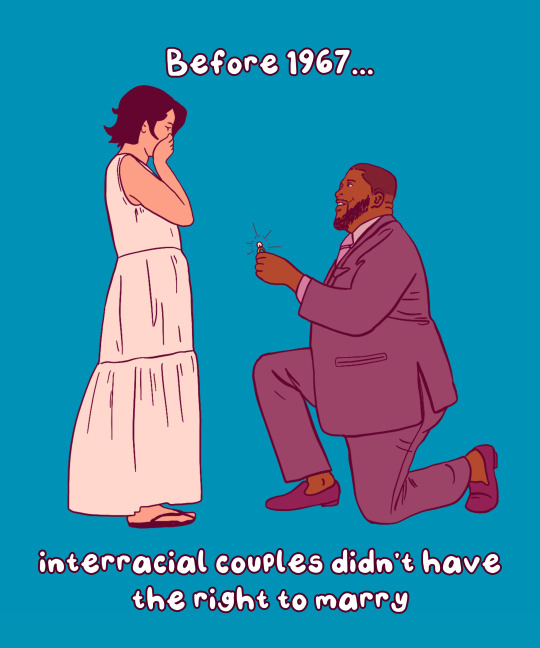
📍 Before 1967, interracial couples didn’t have the right to marry. In Loving v. Virginia, the Supreme Court found that anti-miscegenation laws were unconstitutional. In 2000, Alabama was the last State to remove its anti-miscegenation laws from the books.

📍 Before 1972, unmarried women didn’t have the right to birth control. While married couples gained the right in 1967, it wasn’t until Eisenstadt v. Baird seven years later, that the Supreme Court affirmed the right to contraception for unmarried people.
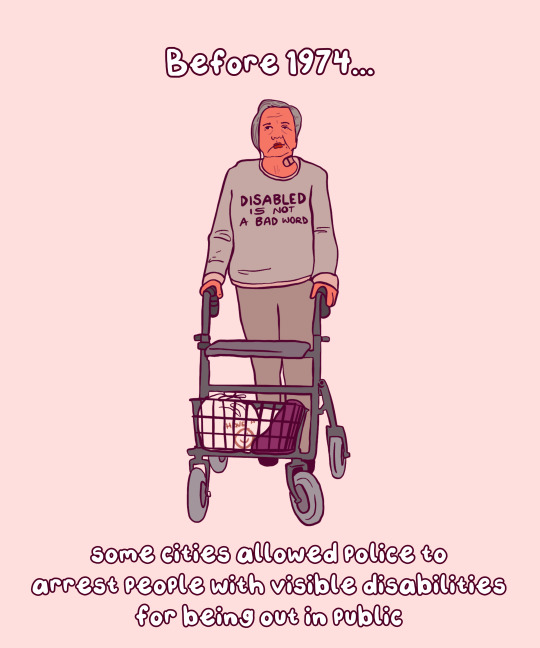
📍 In 1974, the last “Ugly Laws” were repealed in Chicago. “Ugly Laws” allowed the police to arrest and jail people with visible disabilities for being seen in public. People charged with ugly laws were either charged a fine or held in jail. ‘Ugly Laws’ were a part of the late 19th century Victorian Era poor laws.

📍 In 1976, Hawaii was the last state to lift requirements that a woman take her husband’s last name. If a woman didn’t take her husband’s last name, employers could refuse to issue her payroll and she could be barred from voting.

📍 It wasn’t until 1993 that marital assault became a crime in all 50 states. Historically, intercourse within marriage was regarded as a “right” of spouses. Before 1974, in all fifty U.S. states, men had legal immunity for assaults their wives. Oklahoma and North Carolina were the last to change the law in 1993.
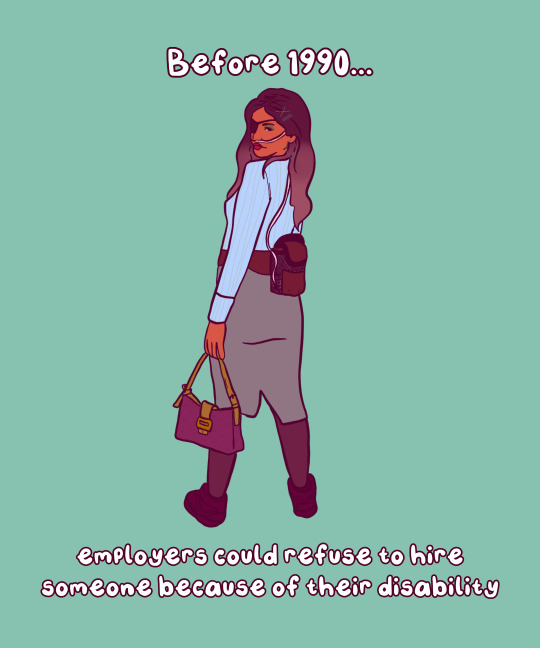
📍 In 1990, the Americans with Disability Act (ADA) – most comprehensive disability rights legislation in U.S. history – was passed. The ADA protected disabled people from employment discrimination. Previously, an employer could refuse to hire someone just because of their disability.
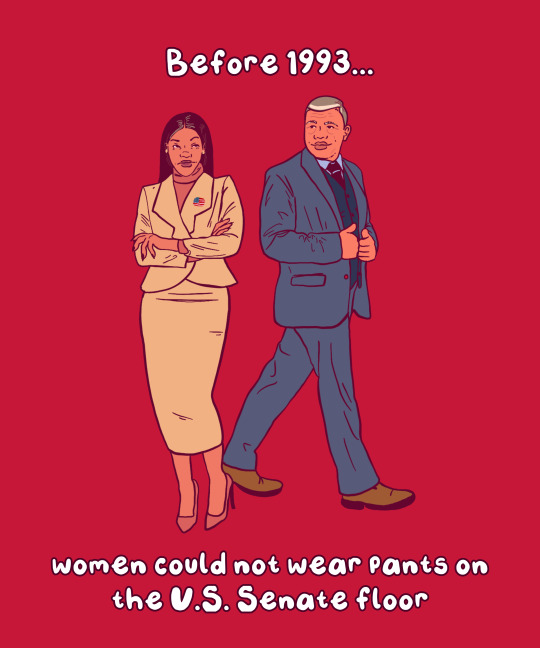
📍 Before 1993, women weren’t allowed to wear pants on the Senate floor. That changed when Sen. Moseley Braun (D-IL), & Sen. Barbara Mikulski (D-MD) wore trousers - shocking the male-dominated Senate. Their fashion statement ultimately led to the dress code being clarified to allow women to wear pants.

📍 Emergency contraception (Plan B) wasn't approved by the FDA until 1998. While many can get emergency contraception at their local drugstore, back then it required a prescription. In 2013, the FDA removed age limits & allowed retailers to stock it directly on the shelf (although many don’t).

📍 In Lawrence v. Texas (2003), the Supreme Court ruled that anti-cohabitation laws were unconstitutional. Sometimes referred to as the ‘'Living in Sin' statute, anti-cohabitation laws criminalize living with a partner if the couple is unmarried. Today, Mississippi still has laws on its books against cohabitation.
#art#feminism#women's history#women's history month#iwd2024#international women's day#herstory#educational#graphics#history#70s#80s#rights#women's rights#human rights
14K notes
·
View notes
Text
thoughts on "tradwives" as a 19th-century social historian
It's great until it's not.
It's great until he develops an addiction and starts spending all the money on it.
It's great until you realize he's abusive and hid it long enough to get you totally in his power (happened to my great-great-aunt Irene).
It's great until he gets injured and can't work anymore.
It's great until he dies and your options are "learn a marketable skill fast" or "marry the first eligible man you can find."
It's great until he wants child #7 and your body just can't take another pregnancy, but you can't leave or risk desertion because he's your meal ticket.
It's great until he tries to make you run a brothel as a get-rich-quick scheme and deserts you when you refuse, leaving your sisters to desperately fundraise so your house doesn't get foreclosed on (happened to my great-great-aunt Mamie).
It's great until you want to leave but you can't. It's great until you want to do something else with your life but you can't. It's great. Until. It's. Not.
I won't lie to you and say nobody was ever happy that way. Plenty of women have been, and part of feminism is acknowledging that women have the right to choose that sort of life if they want to.
But flinging yourself into it wholeheartedly with no sort of safety net whatsoever, especially in a period where it's EXTREMELY easy for him to leave you- as it should be; no-fault divorce saves lives -is naive at best and dangerous at worst.
Have your own means of support. Keep your own bank account; we fought hard enough to be allowed them. Gods willing, you never need that safety net, but too many women have suffered because they needed it and it wasn't there.
#history#women's history#pregnancy mention#my mother (born 1953) drilled this into me from an early age: have a safety net. have a skill and keep it up to date. have your own money#NEVER join bank accounts. keep a hold on your assets.#well and good to be a stay-at-home wife and mother- I know other lesbians who want that even!#but if your partner is your sole financial support...you're courting danger IMO
2K notes
·
View notes
Photo

California’s first woman structural engineer, Ruth Gordon Schnapp, 1970s
#Ruth Gordon Schnapp#women#upl#va#photography#history#women's history#working class history#working class
6K notes
·
View notes
Text

On November 23, 1909, more than twenty thousand Jewish Yiddish-speaking immigrants, mostly young women in their teens and early twenties, launched an eleven-week general strike in New York’s shirtwaist industry. Dubbed the Uprising of the 20,000, it was the largest strike by women to date in American history. The young strikers’ courage, tenacity, and solidarity forced the predominantly male leadership in the “needle trades” and the American Federation of Labor to revise their entrenched prejudices against organizing women. The strikers won only a portion of their demands, but the uprising sparked five years of revolt that transformed the garment industry into one of the best-organized trades in the United States.
#jumblr#jewish#jews#judaism#nesyapost#jewish history#jewish reading#yiddish#Jewish women#American history#women's history#workers history#proletariat#1909#nyc#workers strike
1K notes
·
View notes
Text

In the autumn of 1883, a paper in the nation's capital reported that "an Iowa woman has spent 7 years embroidering the solar system on a quilt" — to teach astronomy in an era when women could not attend college. Her story.
#Women's History Month#women's history#astronomy#craft#quilting#space#science#science and technology#history and literature#culture and society
442 notes
·
View notes
Text
Beyond the Stars: Mae Jemison’s Odyssey ✨

Happy Black History Month!
This Black History Month, we spotlight the extraordinary life of Dr. Mae Jemison, the first African American woman to travel in space. Born on October 17, 1956, in Decatur, Alabama, and raised in Chicago, Illinois, Jemison’s journey into the stars is a testament to the power of dreams and determination.

From an early age, Jemison showed a keen interest in science and space, but noticed the absence of women astronauts. She pursued her passion relentlessly, earning a B.S. in Chemical Engineering from Stanford University and an M.D. from Cornell Medical College. Before joining NASA, Jemison was a general practitioner and served in the Peace Corps in Sierra Leone and Liberia, where she managed health care for other volunteers.
In 1987, Jemison’s dream became reality when she was selected for NASA’s astronaut program. On September 12, 1992, aboard the Space Shuttle Endeavor on mission STS-47, Jemison became the first African American woman to travel in space, serving as a mission specialist. During her eight-day mission, she conducted experiments on weightlessness and motion sickness, contributing valuable data to the field.

Jemison’s honors include induction into the National Women’s Hall of Fame, the National Medical Association Hall of Fame, and the Texas Science Hall of Fame, among others. Her story is not just one of breaking barriers in space exploration, but also of inspiring generations to pursue their dreams, regardless of birth and obstacles.

For more information on Mae Jemison’s groundbreaking journey and contributions to science and humanity, the National Archives holds numerous resources that illuminate the lives and achievements of African American pioneers:
367 notes
·
View notes
Photo
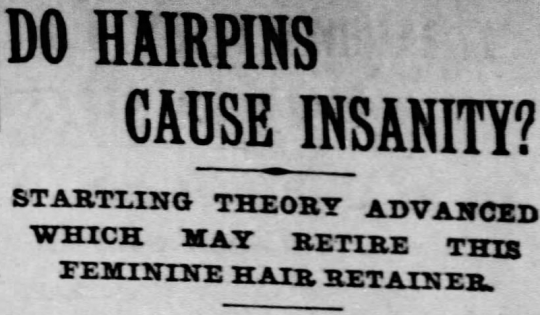
St. Louis Post-Dispatch, Missouri, March 7, 1897
#1897#1890s#victorian era#newspapers#st louis#insane#insanity#historic#vintage#history#victorian#late victorian era#hairpin#bobby pin#hairdo#womens history#women's history#1890s fashion#victorian fashion
2K notes
·
View notes
Photo
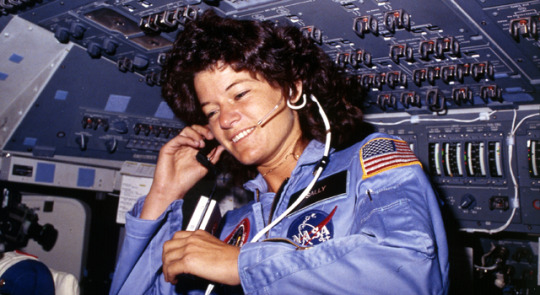
40 years ago today Sally Ride became the first American woman in space and - to the best of our knowledge - the first queer woman in space - when she took part in the Challenger shuttle mission on 18 June 1983. Sally was chosen for the flight because of her expertise with the shuttle’s robotic arm which lifted satellites into orbit. She described her experience as “the most fun I’ll ever have in my life”.
Learn more
[Image: Sally on the 1983 mission, smiling, in her blue NASA suit in space, with various control panels visible behind her]
842 notes
·
View notes
Text
youtube
"Unfortunately, most of the women didn't know they were oppressed. They were brought up in a particular, very strict society, they had to take care of their families, they had mouths to feed, they had work to do. They couldn't even read. And for most of those women, political activism was simply something out of their reach. This is why seeing overtly feminist characters in movies kind of doesn't always work for me. Because, no, your average Becky the Baker's Daughter will not be delivering a speech to her Seamstress Cousin about how men treat her as an object. She simply wouldn't have time for that. But, that being said, women had their ways. They didn't go around shouting feminist slogans in the 17th century, but a lot of women were able to go for their lives like a badass, fucking battery ram. And I'm not only talking about scientists and queens and famous women. Maybe your average Becky the Baker's Daughter couldn't become a lawyer, but that doesn't mean she didn't come over her dad's baking business when he passed away and become the most successful baker in the neighborhood. And maybe her Seamstress Cousin wouldn't be able to attend the university, but that didn't mean she didn't completely rule her household or teach her husband to respect her for who she is." - Karolina Zebrowska
Inspired by this very long post that is worth reading.
148 notes
·
View notes
Text
"Burginda’s letter is instructing the young man in his spiritual endeavours, and the contents of the (albeit short) letter reveal that she was highly educated and well-read. Written in a period that many still refer to erroneously as an intellectual ‘Dark Ages’, Burginda’s letter uses Greek words, utilises biblical exegesis, imitates Christian poetry like the fifth-century Psychomachia of Prudentius, and references both the sixth-century Italian poet Arator and the classical Roman poet Virgil. It also contains a reworking of a description of heaven found in a Latin poem from Africa that dates to c. 500. Burginda was clearly a very well-read intellectual.
This letter can be used as an example to refute many popular misconceptions about the early middle ages. The first misconception is that antique texts were neglected or unknown in this period. The second misconception is that medieval women were uneducated and unintellectual. The third misconception is that there was little or no intellectual transmission between Africa and Europe in this period. Burginda’s letter proves all these assumptions false. Not bad for two paragraphs of Latin."
#burginda#history#women in history#women's history#8th century#england#english history#female writers#herstory#middle ages#medieval#medieval women
449 notes
·
View notes
Text
It's concerning that this is now an LGB and women's issue now, but I really encourage people to begin purchasing USB drives or external hard drives and saving digital research on things such as gay & lesbian history, screenshots of tweets that might be important, homosexual and bisexual research, women's history, radical feminist books or PDFs, and really just anything that is at risk of being "corrected" by gender ideology or made inaccessible by academic publishers.
We need to save these things in a hard copy format as opposed to just using internet archive or taking Sci-hub for granted, because these organizations are experiencing heavy lawsuits. Additionally, it's becoming common for LGB and gender nonconformity history and research to be "rewritten" by gender ideologists. Actually, this is even true for past research and history on transvestism and transsexualism, too, in addition to things such as sex dysphoria, etc.
I bought three 64GB USBs for just $25. If you can't afford an external hardrive, buy some different colored USBs and start building your own library. We need to preserve this information and decentralize it as much as possible. It's worrisome enough that we rely on digital archives this much just generally, especially with the advent of AI and government and corporate attempts to eliminate data privacy and control.
This is a women's rights issue and an LGB issue now.
#human rights#LGB#LGBT#gay history#protect gay history#women's history#women's rights#LGBT history#gender critical#radical feminist#dataprotection#data protection#references#resources#activism#gay activism#lesbian culture#lesbian rights#lesbian history#gay rights#adult human female#feminism
995 notes
·
View notes
Text
I will talk till I'm blue in the face about how historical women have been excluded from academic spaces but I also think historical women are judged based on their education level.
Why is dancing frivolous but hunting isn't (albeit dangerous) why is it negative to spend hours sewing but not hours riding.
Yeah she didn't read a book but did her brothers? Did her father? Do you see them as naive or stupid for not owning any books? For not writing anything other than business correspondence? Or are they allowed to absorb culture by ear?
Also how many people do you know who haven't read a book since high school because its really quite a lot of people
139 notes
·
View notes
Text
oh, The Female Economy: The Millinery and Dressmaking Trades 1860-1930 (Wendy Gamber, 1997), we're really in it now
#just read this and I love it so much#history#dress history#clothing history#fashion history#women's history#book recs#nonfiction
220 notes
·
View notes
Text
At the centre of Rosalind Franklin’s tombstone in London’s Willesden Jewish Cemetery is the word “scientist”. This is followed by the inscription, “Her research and discoveries on viruses remain of lasting benefit to mankind.”
As one of the twentieth century’s pre-eminent scientists, Franklin’s work has benefited all of humanity. The one-hundredth anniversary of her birth this month is prompting much reflection on her career and research contributions, not least Franklin’s catalytic role in unravelling the structure of DNA.
. . .
But Franklin’s remarkable work on DNA amounts to a fraction of her record and legacy. She was a tireless investigator of nature’s secrets, and worked across biology, chemistry and physics, with a focus on research that mattered to society. She made important advances in the science of coal and carbon, and she became an expert in the study of viruses that cause plant and human diseases. In essence, it is because of Franklin, her collaborators and successors, that today’s researchers are able to use tools such as DNA sequencing and X-ray crystallography to investigate viruses such as SARS-CoV-2.
. . .
Franklin was an inveterate traveller on the global conference circuit and a collaborator with international partners. She won a rare grant (with Klug) from the US National Institutes of Health. She was a global connector in the booming early days of research into virus structures: an expert in pathogenic viruses who had gained an international reputation and cared deeply about putting her research to use.
It is a travesty that Franklin is mostly remembered for not receiving full credit for her contributions to the discovery of DNA’s structure. That part of Franklin’s life story must never be forgotten, but she was so much more than the “wronged heroine”, and it’s time to recognize her for the full breadth and depth of her research career.
#rosalind franklin#nature#article#science#research#dna#covid#biology#chemistry#physics#medicine#health#histroy#women's history#x ray
609 notes
·
View notes